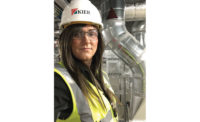Despite the high-tech robots and building-size 3D printers being pitched at ENR’s FutureTech Conference on March 14 in San Francisco, one group of building experts presented a vision of the future that involves something a bit more old-fashioned: teamwork and communication.

“We have a lot of great technology and have made a lot of shifts in process, but as an industry, we haven’t made a shift in paradigm,” says Jim Bratton, engineering manager, virtual design and construction with Dynalectric’s Los Angeles office. “We haven’t truly embraced the possibility to squeeze the potential out of all this [technology].”
During “The Rise of the Super Subs” panel, Bratton and other industry veterans—representing the engineering, architectural, subcontracting and contractor fields—spoke out in favor of better collaboration among project teams. In particular, they called for a much stronger relationship between designers and building trades that goes beyond building information modeling (BIM).
“Collaboration has to be something that we really believe in,” says Gerald Hartford, principal of Hartford Engineering, San Diego. Engineers and subcontractors “need to be on the team together simultaneously very early in the process,” he adds.
Hartford recommends that the mechanical, electrical and plumbing should be removed from the realm of the initial designs, which have no relation to fabrication, and jointly develop the fabrication drawings with subcontractors using their own software. “I don’t need to produce a lot of BIM drawings to facilitate that. I would rather work on the design side and work on what’s really important to make it the greenest and most cost effective design I can make, and let the fabrication side of the equation evolve with and through the subcontractor,” he says.
While the panelists say they fully support BIM, many subs are getting 20% to 30% completed designs due to accelerated project schedules, which increases risk on the contracting side, Bratton says. “We are running into problems where we have to start all over from scratch again. That’s bad for everybody and creates conflict,” he adds.
Others on the panel, such as Dave Pikey, BIM integration director with Franklin Park, Ill.-based The Hill Group, say that as the collaborative approach continues to grow in popularity, the lines in the sand will shift. In 2013, the mechanical contracting firm anticipates it will perform over $100 million of qualifications-based, team-approach, alternative bid work.
“For most projects, especially in the team environment, engineers should not be drawing at all,” Pikey says, “They should be working with the subs to produce those models that actually add value. What really matters to most people in the real world are the cost and the delivery schedule of the building, so let’s make a model that addresses those two things.”
Panel moderator Dave Morris, director of Virtual Construction with Norwalk, Conn.-based EMCOR, contrasted the different paths of technological advancement in the commercial building sector and the industrial sector. As petrochemical and power companies moved from traditional 2D drafting directly into 3D modeling and deliverables, the commercial building market became mired in litigation and traditional contracts that were originally designed over 100 years ago. “We are fighting ourselves every step of the way…and not focusing as an industry on best practices to get us to the finish line,” he says.
Summing up the conversation, Todd Barrett, director of virtual design with Choate Construction Co.’s Atlanta office says the ultimate goal for the industry is a single, holistic, data-rich model that takes the project through the entire lifecycle and even into operations and facilities management.



Post a comment to this article
Report Abusive Comment